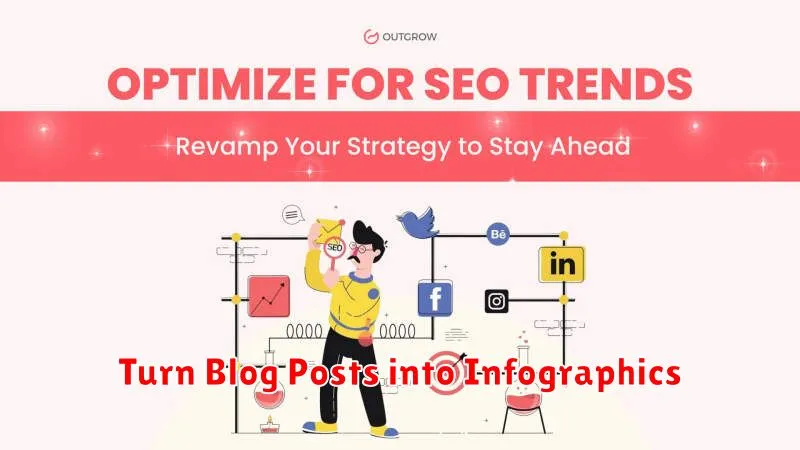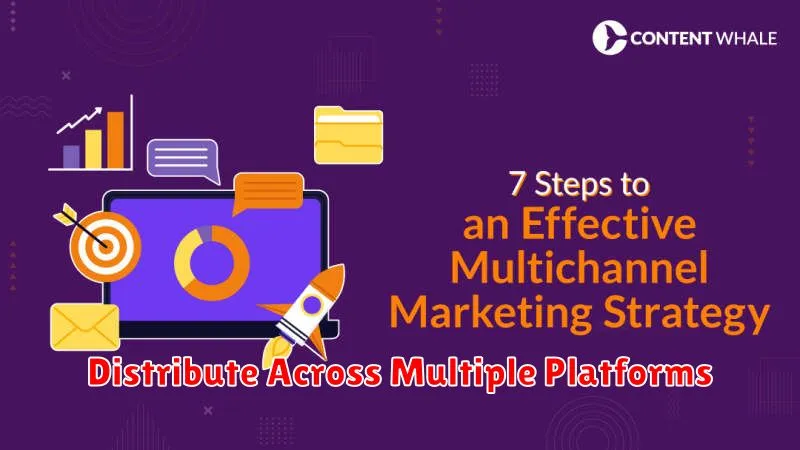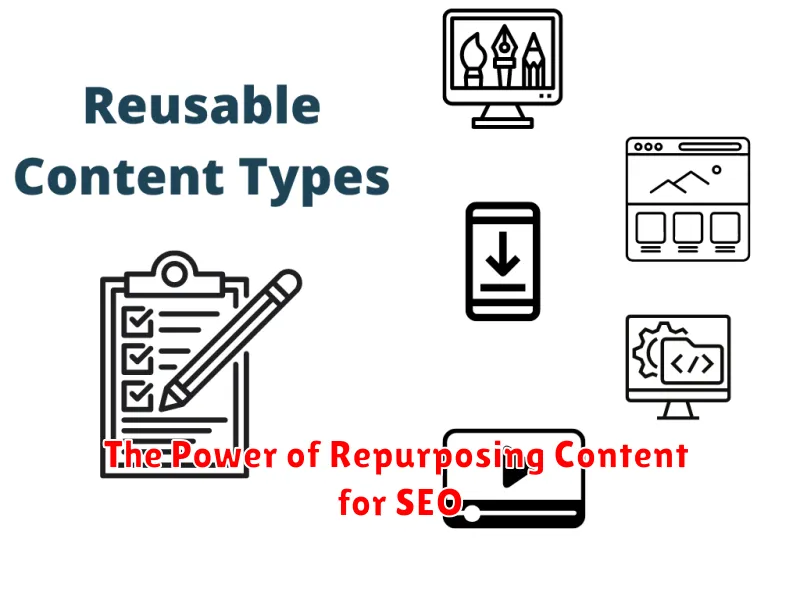In today’s digital landscape, content is king. Creating high-quality, engaging content is crucial for attracting and retaining your target audience. However, creating fresh content consistently can be a time-consuming and resource-intensive process. That’s where the power of repurposing content comes in. By strategically reusing and reformatting your existing content, you can maximize its reach, improve your SEO, and ultimately drive more traffic to your website. Repurposing content allows you to work smarter, not harder, making the most of your valuable content assets.
This article will delve into the numerous benefits of repurposing content for SEO. We will explore various strategies for effectively repurposing different types of content, including blog posts, articles, videos, and infographics. Learn how to transform a single piece of content into multiple formats, reaching a wider audience and strengthening your SEO performance. Discover how repurposing content can save you time and resources while simultaneously boosting your online visibility and driving valuable organic traffic through targeted SEO strategies.
What Is Content Repurposing?
Content repurposing is the process of adapting and transforming existing content into new formats to reach a wider audience and maximize its value. Instead of creating content from scratch every time, you leverage your existing high-performing pieces and modify them for different platforms and purposes. This can involve changing the content’s format, updating its information, or tailoring it to a specific audience.
Essentially, it’s about working smarter, not harder, by getting the most mileage out of your content marketing efforts. You take valuable information you’ve already created and present it in a fresh way to engage new segments of your target audience. This might involve turning a blog post into an infographic, a series of tweets, or even a short video.
By repurposing content, you not only save time and resources but also increase your content’s visibility and reach. It’s a powerful strategy for improving your SEO, driving more traffic to your website, and ultimately, achieving your marketing goals.
Turn Blog Posts into Infographics

Infographics are a visually appealing way to present information and they are highly shareable. Repurposing your blog content into this format can significantly expand its reach.
Identify blog posts rich in data or statistics. These lend themselves well to visual representation. Posts with step-by-step instructions or process explanations can also be effectively transformed into infographics.
Focus on the key takeaways. Distill the core message of your blog post into concise points and choose visuals that clearly communicate these points. Avoid overwhelming the infographic with too much text.
Maintain a consistent brand identity. Use colors, fonts, and a style that aligns with your overall branding. This ensures a cohesive brand experience across all content formats.
Create Short Videos from Articles
Repurposing written content into short videos offers an engaging way to reach a wider audience. Videos are highly consumable and shareable, boosting your content’s visibility across various platforms.
Start by identifying key takeaways and core concepts within your article. These will form the foundation of your video script. Keep it concise, focusing on delivering information clearly and quickly.
Consider using visuals like text overlays, animations, or stock footage to enhance viewer comprehension and retention. A dynamic visual presentation helps maintain audience interest and reinforces your message. Even simple slideshow-style videos with voiceover narration can be effective.
Choose a video style that aligns with your brand and target audience. A formal tone may be appropriate for educational content, while a more relaxed style might suit lifestyle or entertainment topics. Ensure the video’s length is optimized for the platform where it will be shared. Short, snappy videos often perform best.
Update Old Content with New Data
One of the most effective ways to repurpose content is by updating older articles with new data. This keeps your content relevant and accurate, signaling to search engines that your site is actively maintained. Fresh data also provides value to your returning audience, offering them new insights and perspectives.
Identify evergreen content on your site that continues to attract traffic but may contain outdated statistics or information. Review recent industry reports, studies, and data to find relevant information that can be incorporated into the existing content. This could involve updating charts and graphs, revising text passages, or adding new sections with updated insights.
By strategically updating older content, you improve its SEO performance while simultaneously reducing the need to constantly create new content from scratch. This approach is a time-efficient and resourceful way to maximize the value of your existing content library.
Expand FAQs into Guides
Frequently Asked Questions (FAQs) are a valuable resource for addressing common customer queries. However, they often offer brief answers. Repurposing FAQs into comprehensive guides can significantly enhance your SEO performance. By expanding on these concise responses, you provide in-depth information that satisfies user search intent and positions your site as an authoritative source.
Begin by identifying FAQs that cover broader topics. These are prime candidates for expansion. For example, a simple FAQ like “How do I reset my password?” can be transformed into a comprehensive guide on account management, covering password recovery, security best practices, and two-factor authentication.
This approach allows you to target long-tail keywords and increase your content’s visibility. The more detailed information you provide, the greater the likelihood of ranking higher in search engine results pages (SERPs).
Distribute Across Multiple Platforms

Once your content is repurposed into various formats, the next crucial step is distribution. Sharing your content across multiple platforms significantly expands your reach and maximizes your SEO benefits. Think beyond just your website.
Social media platforms are excellent for sharing bite-sized versions of your content, like short videos derived from a longer webinar or quotes pulled from a blog post. Consider the specific audience of each platform and tailor your content accordingly. For example, visually-driven platforms like Instagram benefit from infographics and short video clips, while LinkedIn may be more suited for sharing articles and thought leadership pieces.
Email marketing is another powerful tool for distributing repurposed content. Share snippets of your blog posts in newsletters and direct subscribers to the full article on your website. This drives traffic back to your site and keeps your audience engaged.
Consider platforms like podcast directories if you have audio content or video hosting sites for video content. By diversifying your distribution channels, you increase your chances of reaching a wider audience and strengthening your overall SEO presence.
Boost SEO with Internal Linking
Internal linking is a critical component of on-page SEO. It involves connecting relevant pages within your website, guiding both users and search engine crawlers through your content. Effective internal linking strengthens your site’s overall architecture, improves user experience, and distributes link equity, ultimately boosting your search engine rankings.
When repurposing content, internal linking presents a prime opportunity to connect different formats and perspectives on the same topic. For example, a blog post about content marketing strategies can link to a case study showcasing successful implementation of those strategies.
Consider these key benefits of strategically implemented internal links:
- Improved Navigation: Facilitates easy movement throughout your website, enhancing user experience.
- Enhanced Page Authority: Distributes link equity, boosting the ranking potential of individual pages.
- Increased Time on Site: Encourages users to explore more content, reducing bounce rate.
- Thematic Relevance: Reinforces the topical connection between pages, improving search engine understanding.

